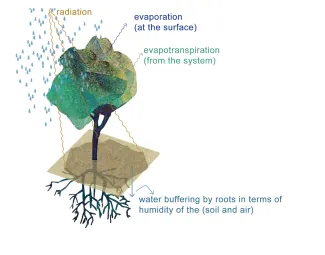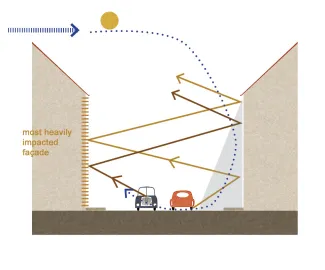Nature-based measures can improve quality of life in Brussels
Natural elements such as trees and other vegetation, but also water, can arm urban areas against heat stress, air pollution and noise pollution. VITO was commissioned by Leefmilieu Brussel to look into the concrete potential gains in the field of green and blue interventions.

So-called nature-based solutions are sustainable measures that make use of natural elements - real or imitated - to tackle typical problems that threaten liveability in urban areas. At the root of these problems is the reality of the city: heat stress due to the heat island effect (caused by the ubiquitous concrete and asphalt), air pollution (due to emissions from traffic and buildings) and noise pollution (due to traffic). Nature-based solutions are characterised by the fact that they address several of these problems at the same time. They are multifunctional and can therefore have a very large impact.
Four different cases in Brussels
The Brussels Region intends to work with nature-based solutions, for example during public works that need to be carried out anyway. But which solutions are optimal for the Brussels context, both for the inner city and for the equally highly urbanised municipalities around it? And what are the potential gains locally? To find out, Leefmilieu Brussel (the dedicated agency for the region) called on experts from VITO and the consultants of Witteveen+Bos.
For four specific cases in Brussels, they investigated how nature-based solutions can provide relief from heat stress, air pollution and noise nuisance. The diverse nature of the cases (a square, a narrow so-called street canyon, a wide street canyon and a neighbourhood next to a motorway) ensures that the results of the study are very widely applicable.
Nature-based solutions are particularly effective in combating heat stress, according to the study (which was completed in 2020). “Shade provided by trees is the most important here”, says Dirk Lauwaet of VITO. “In addition, trees and other vegetation act as green air conditioning by causing water to evaporate through the leaves (transpiration), which has a cooling effect.”
But water can also evaporate directly and thus absorb heat and radiation, so they are not emitted into the environment. This makes 'blue' elements such as fountains and surface water (rivers, streams, etc.) also effective against heat stress. However, it is important to avoid shallow, stagnant water as it releases its stored heat at night, increasing the heat island effect.

Better connected areas
The study shows that green and blue measures can have a local cooling effect of up to three degrees. The highest effect can be obtained when these measures are implemented as much as possible in large, contiguous areas. “To cool down an entire city, a very dense and large-scale network of urban greenery (and blue) is needed”, says Lauwaet.
Nature-based solutions are also effective in terms of noise pollution and air pollution, although the impact is smaller than for heat stress. For noise pollution, dense rows of hedges and trees along streets are the most effective, although this is only true if the source of the noise is not too close to the recipients (e.g. pedestrians). In addition, green soil and façade coverings such as grass or other herbaceous vegetation can provide noise attenuation and absorption.

Trees appear to be the best air purifiers, followed by shrubs, herbs and grasses. Vegetation not only filters the air but can also help remove pollution such as fine dust, soot and nitrogen oxides. Lauwaet: “Lines of trees can form a barrier between pollution sources (such as fuel vehicles) and people in the city. Ideally, they create air currents that cause polluted air to rise quickly so that it does not remain in the city.”
With the study, Leefmilieu Brussel now has a detailed guide for working with nature-based solutions in the coming years. It is expected that new urban greenery and blue will significantly improve the quality of life in the capital.
Read more (in Dutch)
- https://leefmilieu.brussels/het-leefmilieu-een-stand-van-zaken/volledige-versie/leefmilieu-voor-een-duurzame-stad/vergroening-om-stedelijke-ruimten-koeler-te-maken-op-de-natuur-gebaseerde-oplossingen
- https://leefmilieu.brussels/het-leefmilieu-een-stand-van-zaken/volledige-versie/leefmilieu-voor-een-duurzame-stad/vergroening-om-de-plaatselijke-blootstelling-aan-lawaai-te-verminderen-op-de-natuur-gebaseerde-oplossingen
- https://leefmilieu.brussels/het-leefmilieu-een-stand-van-zaken/volledige-versie/leefmilieu-voor-een-duurzame-stad/vergroening-om-de-plaatselijke-blootstelling-aan-luchtverontreiniging-te-verminderen-op-de-natuur-gebaseerde-oplossingen


